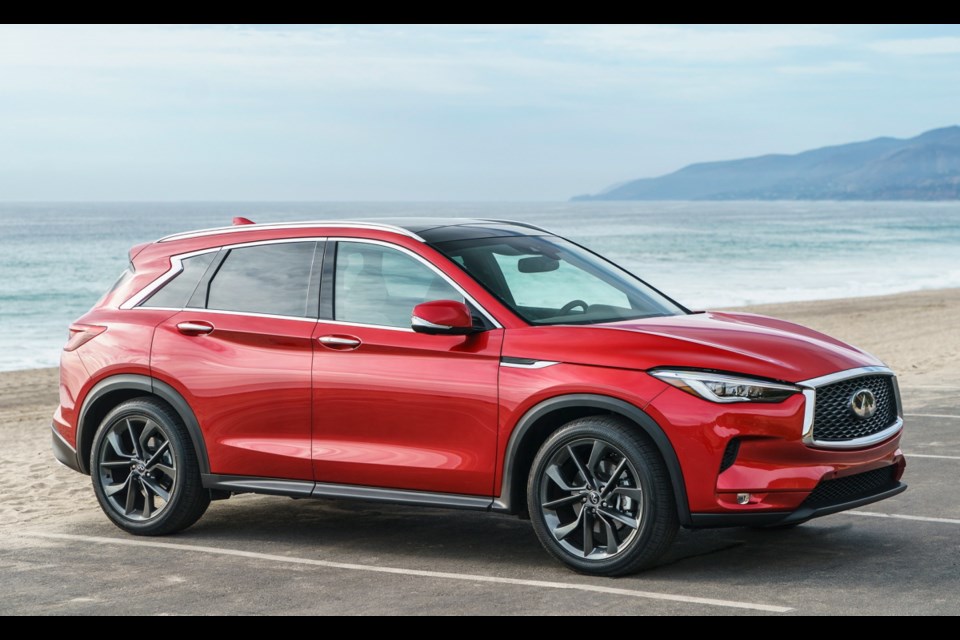If you value innovation in your next new luxury automobile, the recently introduced 2019 Infiniti QX50 would definitely make it in your short list.
The redesigned QX50 slots between the entry-level QX30 and the larger, seven-passenger QX60 in Infiniti’s crossover lineup. This is the second generation of the QX50. It was previously known as the EX35 (and later as the EX37), which first hit our shores in 2008.
The QX50 is available in five trim levels, starting at $44,490. I drove the Sensory, the second-from-the-top model, with a list price of $56,490.
While the QX50 is far from a halo car, the most expensive or the fastest of the brand, it has surprisingly been the first recipient of innovations far ahead of its brethren.
The EX (its former model) was the first production vehicle to offer an all-around view monitor to give a driver a top-down view of the area around the vehicle. More than 10 years ago, it debuted a lane-departure prevention system — a system now becoming more common in modern vehicles.
So it came as no surprise (to me at least) that Infiniti chose the EX50 to debut its newest innovation — an internal-combustion engine that can vary its compression ratio.
The company’s engineers say it has taken them 20 years to accomplish the feat, which promises to maximize engine efficiency and enhance fuel efficiency.
True to Infiniti’s love for acronyms, the variable-compression turbocharged engine is referred to as the VC-T engine.
The feat of engineering comes down to the way the engine can change how far its pistons rise, which effectively changes the engine’s compression. It achieves this by incorporating a joint between the crankshaft and connecting rods. By varying the stroke (by 1.2 millimetres) it varies the engine’s displacement — from 1,971 to 1,997 cc.
This causes the compression ration to range from 8:1 to 14:1.
The turbocharged 2.0-litre four-cylinder produces 268 horsepower and 280 pound-feet of torque. While the horsepower is decent, it is the torque developed that stands out. It beats out the larger QX60, which uses a 3.5-litre V-6, by 10 lb.-ft. of torque.
Fuel economy is exemplary: 10.0L/100km in the city and 7.8 on the highway, easily besting the Audi Q5 and Acura RDX, two close competitors. Infiniti says that the QX50 can run on regular fuel, but for best performance, premium is recommended.
If you are an enthusiast, you might pause here, as the QX50 is fitted with a continuously variable transmission. Nissan and Infiniti have perhaps the best CVT that mimics a conventional automatic transmission, complete with faux gear changes. But every once in a while — say, accelerating hard to merge on an onramp — the engine roars as the revs soar. It doesn’t last long, but it isn’t something you will encounter in other premium vehicles with conventional automatics.
Barring the CVT, the engine is eager to please, with good response and hardly any turbo lag. At speed it is whisper-silent.
The interior is understated and there is a sense of space and elegance that puts it on the upper echelon of the compact luxury segment. The fit and finish is excellent, with soft, luxurious tailored leather surfaces interposed with elegant detailing using wood or metal surfaces.
The 2019 QX50 is 100 millimetres wider than its predecessor, and is now wider than competitors such as the RDX and Q5. It is even wider than the larger Lexus RX350.
This gives the QX50 cabin a spacious feel.
The driver is presented with a conventional dashboard and two screens on the centre stack. If you haven’t warmed to the trend of floating a screen on top of the dash as some manufacturers have done, you’re going to like the QX50’s placement of the navigation screen back in the dash. The bottom screen displays audio controls, cellphone, vehicle settings and apps (yes, apps are making inroads in vehicles as well).
The only unconventional control is the gear selector. Instead of the usual PRND, Infiniti has chosen to require you to pull to the left to engage reverse (over and up) and drive (over and down). You need to press a button to put it into park.
The start/stop push-button is located on the transmission tunnel next to the gear shift.
The front seats are both comfortable and supportive, but the lumbar support cannot be individually positioned — a feature found on many of its competitors.
The rear bench seats can slide, giving rear occupants extra legroom. While there is room for three, it is more luxurious with only two adults.
Trunk capacity is between 895 and 1,699 litres, easily besting the Q5 and even the RX350.
Once again, the QX50 manages to shine with its newest reincarnation. It has introduced innovative technologies while retaining its luxury roots. Competitors will be wise to pay attention, lest they be left behind in this competitive field.
THE SPEC SHEET
Type: Compact crossover, front engine, all-wheel-drive
Engine: Turbocharged 2.0-litre four cylinder, 268 hp at 5,600 r.p.m., 280 lb.-ft. of torque at 4,400 r.p.m.
Transmission: CVT
Dimensions (mm): Length, 4,691; width, 1,903; height, 1,677; wheelbase, 2,800
Curb weight (kg): 1,795
Price (base/as tested): $56,490/$58,635 (includes $2,045 freight and PDI and $100 AC tax)
Options: Nil
Tires: 235/55 R19
Fuel type: Regular/ premium
Fuel economy (L/100km): 10.0 city/ 7.8 highway
Warranty: Four years/100,000 km new car, six years/110,000 km powertrain



